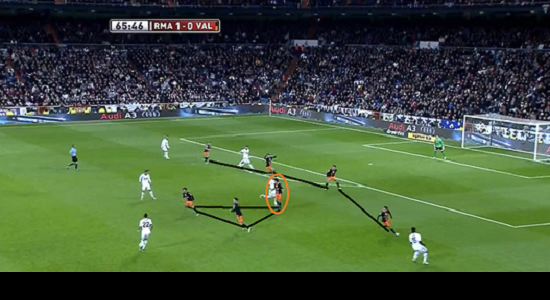In the first quarter final fixture of the Copa del Rey, Real Madrid came out on top with a 2-0 win over Valencia at the Santiago Bernabeu. Valencia were dominant in the passing and possession side of the game but were unable to handle Real Madrid’s counter attacks as shown by Karim Benzema’s opener. An unfortunate own-goal from Andres Guardado sealed the game, with Los Che having to overcome a 2 goal deficit at the Mestalla.

Line-ups: Real Madrid (4-2-3-1) – Valencia (4-3-3) [www.this11.com]
First Half
Valencia Width
The first half was an all action, end to end game with chances falling to both sides, with both teams managing 7 shots each. Valencia were dominant in the possession department by a clear mile and ended the half with 56% possession; they oozed confidence on the ball as well. They calmness on the ball was largely due to their impressive wide play; Guardado and Pereira spread the play wide as soon as Valencia regained possession and provided options for team mates as well as new angles for the centre midfield trio.

Gaps start to emerge in the Madrid defence, due to Valencia’s use of width.
As we can see from the diagram, Pereira (circled bottom) and Guardado (circled top) are as wide as possible; hugging the touchline if you wish. The impact is evident, especially Pereira’s width and due to this, Marcelo has no option but to come out wide to mark Pereira leaving a gap (black box) between him and team mate Carvalho. Runs from the emerging Costa doesn’t allow Carvalho to cover the space between him an Marcelo because Costa is a threat so he finds himself in a tricky situation. This carried on throughout the half right up until the last few minutes of the half:

Another gap appears in the Madrid defence, even though Pereira isn’t in the opposition half.
It’s quite a similar situation, although Pereira isn’t as high as previously. Even so, on the left side of the pitch, Ozil is being drawn in to a more central position to block the passing lane from Adil Rami (in possession) to Victor Ruiz (furthest Valencia player on the left). As Ozil has done this, it has created a 2 on 1 situation on the far left hand side; Guardado and Piatti vs Essien. Neither Alonso or Khedira can move from their positions to help Essien because both are marking the two Valencia midfielders, Banega and Costa. Albiol could shuffle across but then this would leave a big gap for Roberto Soldado to cause danger – something you can ill afford to do. So it’s a major dilemma for Essien finds himself in; shuffle across and fill the gap, or stay with your marker. We can see from the next diagram what happens less than 30 seconds later.

30 seconds later, the gap has been minimized but it’s still visible.
Parejo takes over possession and finds him being closed down by Luka Modric. Pereira has pushed up higher and Guardado (far side) has basically stayed static. Banega has found himself in a terrific position between the defence and midfield and causes a new problem but for Marcelo this time around. Cristiano is ball watching and hasn’t tracked back, so Pereira is an option for Parejo in which Marcelo has to mark. Mentioned previously, Banega has picked up a solid position in the middle and it would cause great danger to Real Madrid if he was played in. Carvalho could leave Soldado and come across but then there is another gap which Parejo is more than able to pass into. Alonso starts to come across, realising the danger, but in his blind spot Costa is lurking right in front of that gap in the Real Madrid defence.
Due to this width and Real Madrid’s deep defensive line, it made it easier for Valencia when in possession. Keeping calm and collected, it worked to their advantage but they lacked the final pass to make that major difference – a goal.
Madrid Too Central to Damage Valencia
Compared to Valencia, Real Madrid lacked the width to cause danger to Los Che. Marcelo would find himself almost in the central midfielder’s position, as would Essien depending on what side the play was on. Subsequently, this led to Real Madrid forcing themselves down the middle, which worked to no avail.

Between the orange lines is where Real Madrid played, and found little success.
Using the orange lines as a guideline, there are 7 Valencia players between them in a very central format set, with all of them glued to the ball. Essien has picked up a great wide position, but Costa is blocking the passing lane so Modric is unable to use Essien as an option. On the other side, Marcelo has dropped in centrally and doesn’t draw out Piatti enough to create some added space which Real Madrid could potentially use to their advantage. The sequence comes to nothing – all down to the central play which Los Blancos decided to use.
Madrid’s Fearsome Counter Attacks
The first goal game from a counter attack from Real Madrid, and from the time Essien recovered possession to the time Benzema stuck the ball in the back of Valencia’s net was just 10 seconds. Valencia struggled throughout the first half but Benzema’s goal is the best example to use.

Circled in orange, Guardado doesn’t put the effort in and allows Cristiano to brisk past.
The counter attack came because of Valencia’s efforts to go forward. Guardado was up high, attempting to out number a deeper Ozil alongside Piatti and Pereira was doing the exact same on the opposite side with Jonas so this left Rami and Victor Ruiz as the lone centre halves occupying two of the most dangerous attackers in world football. Real Madrid were happy to allow Cristiano and Benzema to stay up high as well as seeing Khedira push up high. Pereira, who is the Valencia player right at the bottom ‘busts a gut’ to get back and track Khedira whereas Guardado on the other side allows Cristiano to skim past him without even attempting to track him. This caused Victor Ruiz to come over and track Cristiano’s run, leaving Rami with both Benzema and Khedira to deal with. Cristiano didn’t even play a part in the goal, but just his run caused problems which could’ve been prevented had Guardado put the work rate in.
_____________________________________________________
Second Half
Valencia Still Creating Width
The second half started in similar fashion. Valencia’s width enabled them more time on the ball, which Real Madrid lacked. Cristiano, Modric, Benzema and Ozil were getting drawn in too centrally when any of Rami, Victor Ruiz or Parejo were in possession, allowing Guardado and Pereira to go wide into acres of space providing an option.

When in possession, Guardado and Pereira peeled off wide creating more options for Parejo.
As we can see from here, Parejo is in possession roughly halfway in his own half after intercepting a pass. Guardado (#17/bottom of the screen) immediately peels of wide as far as the touchline, and Pereira on the other side does the exact same, but Ronaldo fails to follow his run. Piatti (far left Valencia player in the centre circle) also peels off wide into the space and drags Coentrao away with him, creating that gap in the defence I have previously mentioned. Banega slots into the centre circle and Rami drops deep in case Parejo cannot go forward. All of a sudden, within 5 seconds Parejo has 5 options available to him, which is perfect for a midfielder – the more options the better. Real Madrid failed to counter Valencia’s width due to them all playing far too centrally.
Parejo Drops Deeper
From this we can also see how deep Parejo is (in possession of the ball). This was an important factor for Valencia as he proved the stumbling block which prevented Real Madrid’s counter attack more often than not. I like to say he is in the ‘Busquets role’ (I know players have positioned themselves like this before and even now, but Busquets in my opinion is by far the best holding player in the world).

Parejo has dropped into the position just behind the centre midfielders and in front of the defence.
From the diagram above, we can see the basic positioning of Valencia in the 2nd half. The back four is in a fairly solid position, maybe with the exception of Guardado. Banega and Costa put pressure on the Real Madrid player in possession (Angel Di Maria in this case) while Parejo has just tucked in behind to mark Ozil. This completely bewildered Real Madrid’s central players as instead of 2 centre-halves they now have a defensive midfielder to get beyond. Parejo was solid in there, and prevented most of Los Blancos’ central counter attacks which we all know are deadly.
Madrid Finally Find Width
Even though the game seemed sealed after Guardado’s own goal, Real Madrid still attacked Valencia searching for more goals to put more sunlight between the two for when they meet on the 22nd of January. The best chance since the second goal came via Real Madrid using width.

Real Madrid’s attacking trio spread wide and Valencia stayed central.
Circled, we can see Ronaldo and Di Maria at the bottom and circled at the top is Ozil. Ronaldo and Di Maria make the exact same run, wrongly, but still creates havoc for Valencia even though both of them are offside. We can see that 5 Valencia players are in and around the centre circle, and no one has even noticed Ozil’s surging run behind them. There’s no positional sense from the Valencia players and due to them all being too central, Madrid opt to go out wide where they find success and create a fantastic opportunity. From another angle:

From another angle, we can see Pereira is the only Valencia player who starts to get back.
From this angle we can see that Pereira is the only one who starts to track back and attempt to recover the ball or interrupt Madrid’s attacking sequence. Ronaldo and Di Maria are still wide, but neither have been picked up by the other 4 Valencia players which could’ve been costly hadn’t Ronaldo missed his chance. The 5 Valencia players, with the possible exception of Pereria who is starting to sprint (circled in orange) they’re still in the same central position, within 10-15 yards of each. They’re there by default just because that’s where Real Madrid were previously penetrating the defence, so the use of width from Madrid cause trouble to Valencia’s defence.
_____________________________________________________
Conclusion
Valencia were very hard done by, and used the width of the Santiago Bernabeu effectively, but what they lacked was the final ball in order to grab that much needed goal. Real Madrid were fortunate that Valencia didn’t find the net, and should consider themselves lucky that they have a relatively comfortable margin going into the second leg. Once they did use width, particularly more often in the second half, they had more success and chances on goal but Guaita was very solid in goal other than conceding twice. Ernesto Valverde will find a large amount of positives from this game and it’s certainly a welcoming sign of Valencia improving.


























































